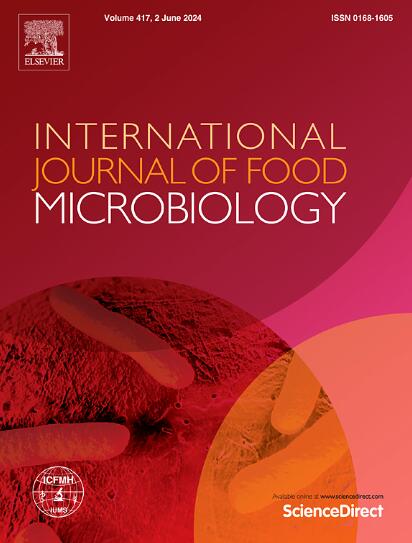Antibacterial mechanism of ultrasound combined with oregano essential oil nano-emulsion on Escherichia coli O157:H7 and application in cherry tomatoes storage
IF 5
1区 农林科学
Q1 FOOD SCIENCE & TECHNOLOGY
International journal of food microbiology
Pub Date : 2025-07-12
DOI:10.1016/j.ijfoodmicro.2025.111348
引用次数: 0
Abstract
Escherichia coli (E. coli) O157:H7 on the surfaces of fruits and vegetables poses significant risks to human health. This study assessed the bactericidal mechanisms of ultrasound (US) and oregano essential oil nanoemulsion (OEON) against E. coli, as well as their application in storage preservation of cherry tomatoes. The results showed that US + OEON treatment exhibited markedly superior inactivation effect on E. coli compared to their individual treatments. OEON (2 %) combined with ultrasonic treatment (375 W) for 4 min reduced the viable E. coli count by 5.06 ± 0.22 log CFU/mL. This performance markedly exceeded that of single treatments, with US achieving 1.15 ± 0.10 log CFU/mL reduction and OEON 1.04 ± 0.18 log CFU/mL reduction. The synergistic treatment intensified lipid peroxidation of bacterial cell membranes and enhanced membrane permeability. Furthermore, in preservation applications on cherry tomatoes, US + OEON effectively suppressed total viable counts, achieving a 1.44 ± 0.19 log CFU/mL reduction after 4-min treatment with 2 % OEON combined with 375 W US. This approach induced no adverse effects on cherry tomato color, texture, nutritional composition, or antioxidant properties. In summary, compared to US or OEON treatment alone, US + OEON treatment exhibits superior antibacterial effect and improves the storage quality of cherry tomatoes.
超声联合牛至精油纳米乳对大肠杆菌O157:H7的抑菌机理及在圣女果保鲜中的应用
水果和蔬菜表面的大肠杆菌O157:H7对人类健康构成重大风险。研究了超声(US)和牛至精油纳米乳(OEON)对大肠杆菌的杀菌作用机理,以及在圣果保鲜中的应用。结果表明,US + OEON处理对大肠杆菌的灭活效果明显优于单独处理。OEON(2%)联合超声(375 W)处理4 min,使活菌数减少5.06±0.22 log CFU/mL。这一性能明显优于单一处理,US降低了1.15±0.10 log CFU/mL, OEON降低了1.04±0.18 log CFU/mL。协同处理增强了细菌细胞膜的脂质过氧化,增强了细胞膜的通透性。此外,在保存应用中,US + OEON有效地抑制了圣女果的总活菌计数,在2% OEON联合375 W US处理4分钟后,总活菌计数减少了1.44±0.19 log CFU/mL。这种方法对樱桃番茄的颜色、质地、营养成分或抗氧化性能没有不良影响。综上所述,与单独使用US或OEON处理相比,US + OEON处理具有更好的抗菌效果,提高了圣果的贮藏品质。
本文章由计算机程序翻译,如有差异,请以英文原文为准。
求助全文
约1分钟内获得全文
求助全文
来源期刊
CiteScore
10.40
自引率
5.60%
发文量
322
审稿时长
65 days
期刊介绍:
The International Journal of Food Microbiology publishes papers dealing with all aspects of food microbiology. Articles must present information that is novel, has high impact and interest, and is of high scientific quality. They should provide scientific or technological advancement in the specific field of interest of the journal and enhance its strong international reputation. Preliminary or confirmatory results as well as contributions not strictly related to food microbiology will not be considered for publication.

 求助内容:
求助内容: 应助结果提醒方式:
应助结果提醒方式:


